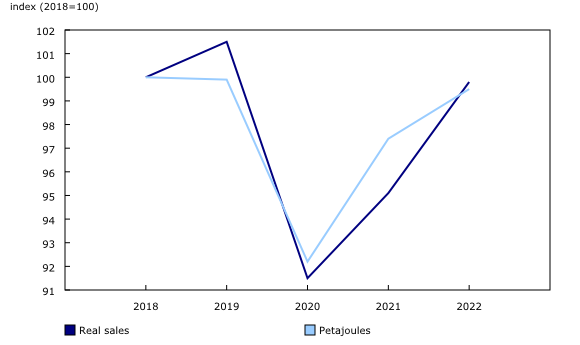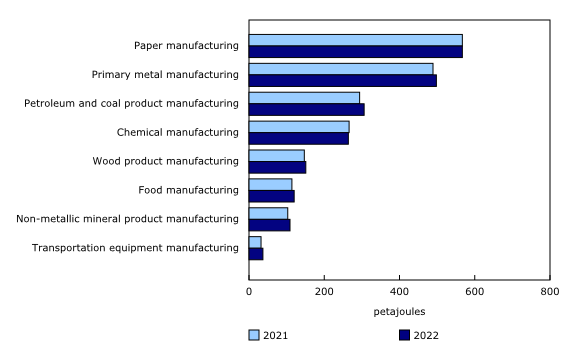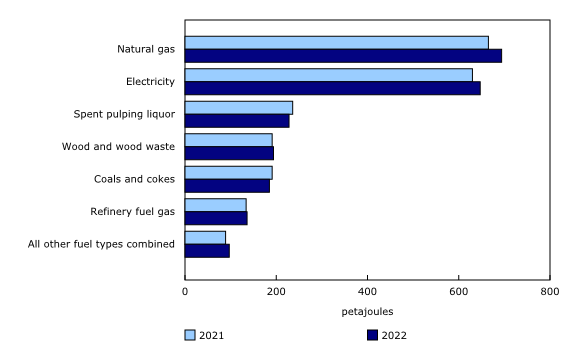Energy consumption by the manufacturing sector, 2022
Released: 2023-10-30
2 181 petajoules
2022
2.2% 
(annual change)
Energy consumption by the manufacturing sector increased by 2.2% to 2 181 petajoules from 2021 to 2022. The demand for manufactured products has continued to grow since the reopening of the economy in 2021.
Real sales for the manufacturing sector increased 4.9% from 2021 to 2022, and the annual average capacity utilization rate rose 1.1% during this period.
Although manufacturing activity increased in 2022, it remained below levels observed before the COVID-19 pandemic. In 2022, real sales were 1.7% lower and energy consumption was 0.5% lower compared with 2019.
For context, one petajoule equals approximately the amount of energy required to operate the Montréal subway system for one full year.
Paper and primary metal manufacturers continue to be the top energy consumers
In 2022, the top energy consumers were paper manufacturers (566.9 petajoules) and primary metal manufacturers (498.3 petajoules), which together accounted for almost half (48.8%) of all energy consumed by the manufacturing sector. Petroleum and coal product manufacturing (306.5 petajoules) and chemical manufacturing (263.5 petajoules) accounted for another 26.1% of energy consumption.
The consumption of energy in the manufacturing sector is not necessarily indicative of sales volumes. Despite making up close to half of energy consumption, paper manufacturing and primary metal manufacturing accounted for 11.4% of the total real sales of goods manufactured (shipments) in 2022.
Petroleum and coal product manufacturing and primary metal manufacturing account for almost half of the 2022 increase in energy consumption
The economy continued to reopen in 2022, and the demand for energy products increased. Petroleum and coal product manufacturing increased energy consumption by 12.3 petajoules (+4.2%) and primary metal manufacturing increased energy consumption by 9.2 petajoules (+1.9%) over 2021. Together, they accounted for 46.6% of the total manufacturing increase in energy consumption.
The transportation equipment manufacturing industry, which had experienced supply chain issues in 2021, consumed 14.4% (+4.6 petajoules) more energy in 2022 as global supply issues began improving.
Natural gas and electricity are the largest sources of energy consumed
Natural gas and electricity, the most common sources of energy, are used in all manufacturing industries.
In 2022, 694.0 petajoules of natural gas were consumed, accounting for almost one-third (31.8%) of the total energy used by the manufacturing sector. The largest consumers of natural gas were chemical manufacturing (155.3 petajoules) and primary metal manufacturing (115.9 petajoules), which combined accounted for 39.1% of the total natural gas consumed. Electricity accounted for 646.8 petajoules (29.7%) of total energy consumed by the manufacturing sector. The primary metal manufacturing industry (270.8 petajoules) and the paper manufacturing industry (123.5 petajoules) were the largest electricity consumers, accounting for 61.0% of total electricity consumed.
Spent pulping liquor was consumed solely by the paper manufacturing industry. At 228.1 petajoules, it accounted for 10.5% of the total energy consumed in 2022. Wood and wood waste, which were primarily used by the wood product and paper manufacturing industries, accounted for 8.9% of the total energy consumed, at 194.2 petajoules. Coals and cokes, at 185.4 petajoules, accounted for 8.5% of the total energy consumed. The primary metal, petroleum and coal product, and non-metallic mineral product manufacturing industries were the primary users of coals and cokes. At 136.0 petajoules, refinery fuel gas, mainly consumed by the petroleum and coal product manufacturing industry, made up 6.2% of total energy consumed. All other energy sources combined accounted for the remaining 4.4% of total energy consumed.
Note to readers
The Annual Industrial Consumption of Energy Survey, sponsored by Natural Resources Canada and Environment and Climate Change Canada, estimates the energy consumed by type of fuel in Canadian manufacturing.
The 2022 survey estimates are based on a sample of 4,982 manufacturing establishments, which represent a weighted response rate of 84.97%.
A joule is a derived measure of energy or work. One gigajoule is equal to 1 billion (109) joules. The energy content of a 30-litre tank of gasoline is about one gigajoule, and six gigajoules are roughly equivalent to the amount of potential energy from burning one US standard barrel of oil. One petajoule is equal to 1015 joules, or 1 million gigajoules.
Energy includes the energy used as fuel to power the production process, for heating, for transportation at the establishment and for generating steam consumed on site.
Other energy sources include butane, heavy fuel oil, middle distillates, propane and purchased steam.
Electricity consists of both purchased and self-generated electricity.
Coals and cokes grouping includes coal, coal coke, coke oven gas, petroleum coke and coke from catalytic cracking.
Totals and percentages may not add up because of rounding.
Manufacturing sales are from table 16-10-0013-01.
Manufacturing capacity utilization rates are derived from table 16-10-0012-01.
Data for 2021 have been finalized. Data for 2022 are subject to revision.
Contact information
For more information, or to enquire about the concepts, methods or data quality of this release, contact us (toll-free 1-800-263-1136; 514-283-8300; infostats@statcan.gc.ca) or Media Relations (statcan.mediahotline-ligneinfomedias.statcan@statcan.gc.ca).
- Date modified:



